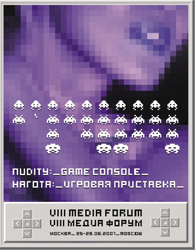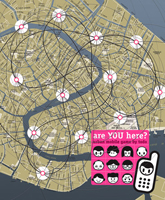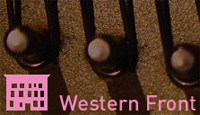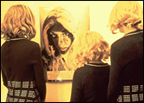July 06, 2007
Nina Czegledy reports on Media Forum 2007

Nudity:_Game Console_
Between June 25-28, Media Forum, Moscow in collaboration with the Moscow International Film Festival, presented Nudity/Game console - a series of events including a Vito Accoinci retrospective, round table discussions and a video art competition. The theme of this year was: Nudity/Game console. The ERA Foundation hosted the Media Forum events in their centrally located, elegantly renovated gallery space.
In this report I would like to focus on the round table discussions - especially as the majority of the presenters happened to be women working with research & practice in digital fields/communities. Instead of lengthy descriptions, links are provided below for further information.
"Cultural cooperation online", the first discussion on June 26th was presented by Angela Plohman, content developer of Labforculture. The organization provides extremely useful tools for those in the arts who wish to collaborate across borders. The constructive, practical value of this information and knowledge platform was very much appreciated by the audience as attested by the numerous questions and comments.
On June 27, Anne Nigten of V2 lectured on "Research and development in the interdisciplinary field from an art perspective" followed by Dmitry Bulatov on "The third modern - denuding the media. The technobiological art work." Last but not least Margarete Jahrman showed us "Pong Dress" and Ludic Society. All of these presentations were very well received with lively Q&A periods.
Next day, June 28, "Super-Embodiment of Woman Artists in Media Arts" was presented by Irina Aristarkhova, Nina Czegledy and Elena Kovylina. Irina noted in her introduction that "Nudity and the Nude - have become key issues in contemporary art, theory and politics. Women artists face what Foucault called 'hysteriarization of female body', while men artists face an issue of 'absent male body' (Kelly Oliver) and respond to it with various strategies. One might argue that both Western and Eastern European women artists have exhibited 'too much body', and to a certain extent find it difficult to leave "body" behind. However, we rarely discuss what impact socialist gender policies and practices have had on this process within aesthetics. If performance art leaves us with legacy of 'too much body' - 'super-embodiment', - one wonders of it morphs into (new) media art as question of 'machine' / 'cyborg' embodiment and its identity."
In the course of our presentations both Irina and myself emphasized that feminism and gender issues can not be separated from the particular history of the region. Lack of clarification of this issue leads to numerous misconceptions and miscommunication. Case histories of media art were presented including "I am a robot" by Boryana Dragoeva Rossa (Bulgaria) and "Reality Resonance" by Erika Katalina Pasztor (Hungary), followed by the outstanding Russian performance artist Elena Kovylina, showing her "Pick a Girl" video performance featured at the Sydney Biennale 2006. The questions and comments at the end of our panel revealed that controversy and strife are still embedded in this discourse.
The schedule left room for us to visit some artists studios, participate in the mega-retrospective by Oleg Kulik and Vinzavod and old factory converted into a mixed use art center and luxury boutiques - where hopefully the Media Art Lab will have its future home. There is so much more including Art4 the private contemporary art museum, Moscow Rolls Royce, the electroboutique, traffic jams, night life etc. etc -worth a visit!
nina [via Spectre]
Posted by jo at 10:37 AM | Comments (0)
April 18, 2007
AreYouHere?

Venice - Urban Mobile Game
AreYouHere? :: 2007 - June 6th/15th - Venice - urban mobile game :: AreYouHere? is one of the 12 urban interventions of Migration Addicts, 52nd International Art Exhibition, La Biennale di Venezia, Collateral events :: Site: the whole city - starting point at Chiostro Ex Chiesa Santi Cosma e Damiano, Giudecca, 620.
AreYouHere? is an urban mobile game that aims to explore Venice through its inhabitants/migrants. More and more Venetians are leaving the lagoon to settle in other towns. In the next 30-40 years, it is certain that Venice's population will be dramatically reduced. Bar and hotel owners now come from abroad while the town is losing its original inhabitants and becoming more and more globalized. Thousands of tourists arrive to Venice everyday. The Observer provocatively wrote that if the only destiny of the town is low cost tourism then it would be better to have Venice managed by Disneyland Corporation. A kind of paradox is happening. Venice could be everywhere, that "exotic" does not exist anymore. Labor migrants from Asia are welcoming you and serving you Italian food. You are in Venice. But are you really in Venice? What do you see? Who do you meet?
AreYouHere? is an urban exploration through the faces of the people anyone can meet during his/her stay. Faces of migrants that have become the actual inhabitants, while the player is the stranger. A touristic and personal exploration of people and their faces. Those photos will be joined together into a personal postcard. He/she will receive the postcard at home. A postcard that is actually sent by him/herself. The player will receive the postcard to his/her home: a postcard that is actually sent by him/herself.. But the places you are supposed to visit, however, are not the ones you would expect to go, the top visited.
Surely you'd never take a photo of people who lives and works in these places. But that's what you have to do: shoot photos at immigrant people who live and work in Venice, carefully following the path that has been created for you, because you are the stranger, the tourist, and they are a part of Venice instead. You should take those photos with your mobile phone and send them by MMS to the number you found on the invitation. But remember, the first photo you send must be a photo of yourself: because you are a part of the game. [via]
Posted by jo at 04:34 PM | Comments (0)
April 06, 2007
WESTERN FRONT NEW MUSIC Presents

ALTERNATE VISIONS
WESTERN FRONT NEW MUSIC Presents the West Coast "virtual" premiere of ALTERNATE VISIONS, a new opera by Vancouver composer John Oliver and librettist Genni Gunn :: May 5, 2007 at 5pm :: The Western Front, 303 East 8th Avenue (near Main) :: Admission by donation: Free to Western Front Members :: Reservations / Information: 604 876-9343 / www.front.bc.ca
An alternate vision of love: Staged in Montreal by Chants Libres, and broadcast by a live video stream to the Western Front in Vancouver, this bilingual opera presentation is truly an encounter mediated by cyberspace. Taking the subject matter of computer dating as its focus, Alternate Visions addresses the internet¹s power to create personas and perfection. In a space where musical styles merge, real and virtual universes collide, robotics and intelligent skin mingle...what happens to human carnal relations?
Two singles develop a relationship over the Internet in a virtual 3D environment; they decide to break the ice of cyberspace and meet in person at a high-tech karaoke bar, which is in fact the set of Alternate Visions, a reality television show. At the last minute, they both get cold feet and ask their respective best friends to take their places. Why take the risk? Why change anything?
Misunderstandings multiply ad infinitum, raising questions around the perception of reality and the culture of identity. Cher internet, peux-tu me dire qui je suis?
Vancouver audiences can attend this live large screen video broadcast of the closing night performance of Alternate Visions on Saturday May 5 at 5pm at the Western Front. Please reserve seats by calling 604 876-9343 - admission is by donation at the door. The opera will be performed in English and French.
Music: John Oliver, on a libretto by Genni Gunn. Soloists: Rinde Eckert (tenor, Richard), Jacinthe Thibault (mezzo-soprano, Valerie), ÉthelGuéret (soprano, Susan), Patrick Mallette (baritone, TV host). The three Girls: Jean-François Daigneault (countertenor), Ghislaine Deschambault (soprano) and Claudine Ledoux (mezzo soprano). Musicians: The Bradyworks ensemble, directed by Cristian Gort.
Production team: Pauline Vaillancourt (stage direction), Jean Décarie (visual design and interactivity), Jean Gervais (lighting), Pascal Dufaux (stage design), Liz Vandal(costumes), Joanna Berzowska (interactive textiles), Jacques-Lee Pelletier (makeup).
This opera is co-produced with the DEII(Laboratory of Immersive and Interactive environment development), in partnership with the Hexagram Institute for Research and Creation in Interuniversity Media Arts andTechnologies, and in collaboration with Bradyworks, the Usine C and the CIAM.
Since its beginnings in 1990, CHANTS LIBRES has always presented operatic repertoire with a modern flavor and has constantly explored new techniques and approaches in the sphere of vocal art. The company works in close collaboration with creators and researchers of all disciplines. ALTERNATE VISIONS, the company's 12th operatic production, integrates state-of-the-art technologies.
For further information, contact DB Boyko, Music Curator, Western Front New Music 604 876-9343 newmusic[at]front.bc.ca
Posted by jo at 10:57 AM | Comments (0)
January 23, 2007
New Urban Topologies:

The Desire for Public Place in the Age of Virtual Geography
ABSTRACT: Throughout the history of urban center in the west, the public "square" and "street" have been the predominant locations of participation in the life of the polis. Historically, this has been where political debates and conversations have taken place, domestic turmoil and celebrations have emerged, as well as the expression of unity that comes about when differing individuals begin to develop a common identity often reinforced by the aesthetic qualities and meaning associated with certain places, architecture, or urban forms. Recently, with the rapid rise in influence of telecommunications and other associated technologies, our perceptions of the role of a specific place or urban form in constituting this type of identity have radically changed. This paper will set out to explore the traditional role that these urban spaces have played in the cultivation of a sense of belonging to a group identified with a certain geographical location, how these advances have caused a certain 'placelessness' in modern societies, and how the purpose of these traditionally important spaces might be reconceptualized to produce a new strategy and understanding of urban space. An agenda that attempts to address possibilities and opportunities within the transformation of urban spaces in the context of globalization. Properly defined, such an agenda could speculate on possible new conceptions of urban infrastructural strategies that enhance both the material and virtual experience of urbanity within the rapid transformations seemingly occurring at an increasingly rapid rate. From New Urban topologies: The Desire for Public Place in the Age of Virtual Geography by Michael Jenson, Drain.
Posted by jo at 04:12 PM | Comments (0)
January 02, 2007
Roberta Breitmore (1971-1978)

Virtual Identity Ante-Litteram
Before the advent of online communication, creating a fake trustworthy identity has been more complex than just improvising during a chat using a handful of online tools. Amongst the ancestors of successful invented identities there's the historical project Roberta Breitmore (1971-1978), developed as a nine years performance by Lynn Hershman. With 'Roberta' she pioneered many of the personality games twenty years later experienced in incorporeal communication platforms, such as multiple personalities, parallel relationships, creating new relationships in different media, in the end getting back stimulating human responses with different strategies. Roberta had her own credit card, published advertising for a roommate and had psychiatrist sessions. Even if it was derived from a significant part of the hidden Lynn's own personality, she was meant to be public, but intimate at the same time, so irresistible. And her structured parts (only minimally reflecting the artist's well known ones) formed a coherent, intricated and nonetheless fascinating persona. Always maintaining identifiable aesthetic and behavioral traits, as a living character, Roberta's endangered personality, so ethereal and compromised, seem to be the 'mother' of contemporary incursions in identity alterations." Neural.
Posted by jo at 06:22 PM | Comments (0)
